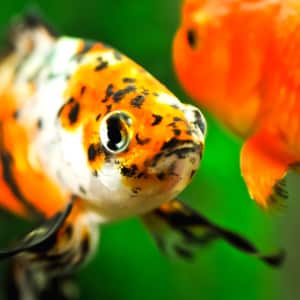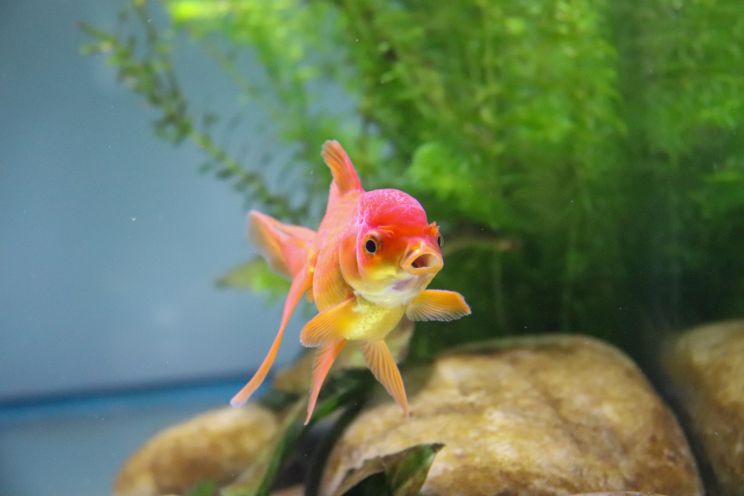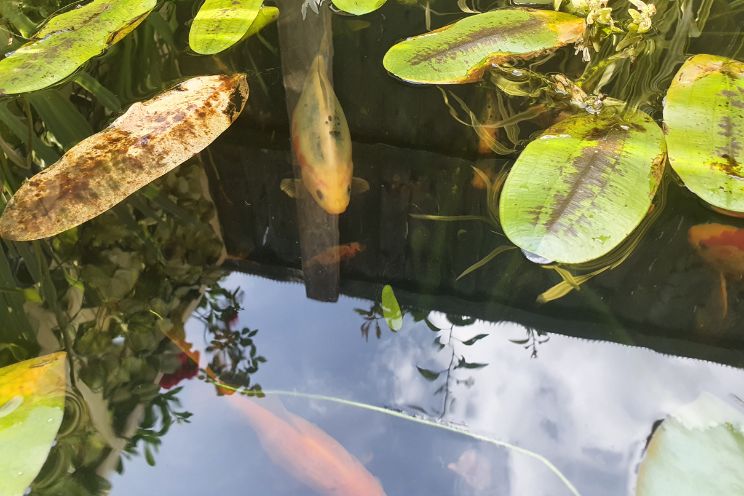No two Shubunkin goldfish look exactly alike! In fact, it’s the fish’s unique coloration that makes them so sought after.
Shubunkins come in three varieties, London, American, and Bristol Shubunkins. All types of these gorgeous fish are best kept in a pond since they can grow to an impressive size of between 12 and 18 inches long.
So, are Shubunkins aggressive? How many Shubunkins can live together? And can Shubunkins thrive in an aquarium?
Keep reading to find out what fish species make the best Shubunkin goldfish tank mates.

What size tank do Shubunkin goldfish need?
All goldfish can grow quite large. Fancy goldfish can reach as much as 8 inches in length, while Comets can reach 14 inches long.
Shubunkins are no exception, reaching between 12 and 18 inches long when kept in a spacious pond. However, tank-kept specimens are generally quite a lot smaller, reaching around 8 to 10 inches long.
If you want to keep Shubunkins in a fish tank, we recommend a tank of at least 75 US gallons (63 UK gallons) to accommodate one Shubunkin! However, goldfish of all species ideally need to live in groups.
Although they’re not strictly shoaling fish, single goldfish quickly become stressed. Stress weakens the fish’s immune system, leaving the fish susceptible to attack by parasites and bacterial diseases. To keep more than one Shubunkin in a tank, you need to add an extra 50 US gallons (52 UK gallons) per fish to the aquarium size.
Pond Living
Not many hobbyists have the space to accommodate a tank of that size, so we recommend that you keep Shubunkin goldfish in a roomy garden pond rather than in an aquarium.
As you know, all varieties of goldfish are directly descended from wild Prussian Silver carp. Those fish live in large water bodies and ponds, tolerating cold winters with ease.
For that reason, we recommend you keep your Shubunkin goldfish in a large garden pond that offers the fish lots of swimming space. Goldfish can survive and thrive in warm and cool water temperatures, creating a dazzling display of colour all year round.

Are Shubunkin goldfish aggressive toward other fish?
Like all goldfish, Shubunkins are gregarious, peaceful fish that are not aggressive toward their own species or others.
That said, goldfish breeding can sometimes appear somewhat violent, with male fish chasing females and repeatedly attempting to mate with them until the poor female literally dies of exhaustion.
If that happens, removing the female fish and giving her a chance to recover while the males cool down is better.
Goldfish are opportunistic omnivores that will quickly snap up fish fry, shrimp, and little crustaceans. That can appear as aggression, although the Shubunkins are simply making the most of an opportunity for a meal.

Can Shubunkin goldfish live with tropical fish?
So, like all goldfish varieties, Shubunkins are coldwater fish happiest in water temperatures ranging from 60° to 70°F.
Generally, tropical fish species need a warmer temperature than that to survive and do well. However, a few temperate species can tolerate cooler water temperatures, such as White Cloud Mountain Minnows, Killifish, Endler’s livebearers, and Celestial Pearl Danios.
However, many of those fish species are too small to live safely with large Shubunkins. That said, two tropical species can live in relative safety with goldfish once they are fully grown and too big to fit into the Shubunkins’ mouths.
Dojo Loach
The Dojo loach is often called the Weather loach.
Weather loaches tend to hang out at the bottom of their habitat. Although these fish are relatively small at around 3 inches long, they need a large aquarium of at least 55 US gallons (46 UK gallons) to be comfortable.
Dojo loaches can grow to around 8 inches in length or more in a pond environment.
You can keep Dojo loaches in an outdoor pond. However, if you live in a cold region where the temperature regularly falls below freezing, we recommend that you overwinter your loaches indoors.
The novel thing about these fish is that they are highly sensitive to barometric pressure changes, becoming almost hyperactive when the pressure fluctuates. So, if you see your Weather loach manically charging around the pond, you know there’s a big storm on its way!
If you have your Dojos living in a pond, you won’t see much of them since they spend much of their time foraging around on the substrate. However, loaches kept in a fish tank are proven escape artists, so you’ll need an aquarium with a lid or cover slide to prevent the fish from ending up on your living room carpet!
Dojo ban!
If you live in Australia or New Zealand, we don’t recommend that you keep Dojo loaches in a pond. During floods, the fish have escaped into local water bodies, quickly becoming an invasive nuisance species.
Although it’s not illegal to keep Dojo loaches in the UK, you will need the appropriate paperwork if you want to embark on a breeding project and sell the offspring.
Corydoras Catfish
If you choose to keep your Shubunkins in a large tank, you could add a small school of Corydoras catfish to the community.
Corydoras are a species of catfish that spend their lives on the bottom of the tank, foraging through the substrate, looking for scraps of food.
There are over 100 species of Corys, some of which grow to over 4 inches in length, so your Shubunkins won’t attempt to eat them.
Corydoras are schooling fish, so you’ll need to have at least six or more for the fish to be happy.

Best tank mates for Shubunkin goldfish
Of course, if you keep your Shubunkins in a pond, you have a much wider choice of fish that you could keep with them.

Comet goldfish
Comet goldfish can make good pond mates for Shubunkins.
Comets are slim-bodied goldfish that can grow to reach 14 inches in length when kept in a large pond setting. Like all goldfish species, Comets are peaceful fish that do best when kept in groups.
Comet goldfish share the same dietary requirements as Shubunkins, and they have the same needs when it comes to water parameters and temperatures. When kept together, these two species make a colourful, spectacular display in your pond.
Koi
Koi are extremely popular pond fish that are often kept as companions for goldfish, including Shubunkins.
Like Comets, Koi share the same basic requirements with regard to water parameters, food, and the general environment. And did you know that Koi and goldfish are closely related, and they can breed?
However, Koi can reach 3 feet or more in length when fully grown and can live for over 35 years when kept in optimum conditions.
Orfe
Orfe, or Golden Orfe, are pond fish that was extremely popular when it first appeared in the hobby during the 1960s and 1970s.
Orfe need pretty much the same water conditions and living environment as Shubunkins, Koi, and Comets.
However, these beautiful fish can grow up to 2 feet in length, and they are schooling fish. So, you need a large pond to keep this species successfully.
Sterlet
The Sterlets are very similar to the much larger sturgeon.
Sterlets are basically similar to common catfish, primarily living on the substrate and foraging for worms and crustaceans to feed on. These fish are tolerant of harsh winter conditions and won’t bother your Shubunkins and other pond residents.
Carp
Common carp and Grass carp are very closely related to Shubunkins and other goldfish varieties, and their lifestyles are similar.
These carp varieties need the same conditions and food as goldfish, but they do grow larger, sometimes reaching over 3 feet. Carp can generally survive harsh winter conditions.
Frogs
Frogs and goldfish can usually live together harmoniously in a pond. If you grow flat-leaved plants, such as water lilies, in your pond, you can enjoy watching your frogs when they venture above the waterline.
Snails
Snails are helpful creatures in a tank or pond, eating decaying plant matter, fish waste, and general detritus and keeping the habitat clean.
Your goldfish won’t bother attempting to eat larger snail species, and the snails breed rapidly, so you won’t need to buy more. However, Shubunkins and other pond fish will probably eat juvenile snails and snail eggs, which helps to control the mollusk numbers.
Unsuitable tank mates for Shubunkin goldfish
Shubunkins are fast swimmers that can grow quite large, and they tend to do best when kept with similar types, such as those species mentioned above.
We don’t recommend keeping slow-swimming Fancy goldfish varieties with Shubunkins. The Fancies will probably get bumped and barged at feeding times, potentially leading to starvation, stress, injury, and even death.
In particular, Bubble Eye and Telescope Eye goldfish should be avoided, as these fish don’t have good vision, and their slow, clumsy swimming style means they simply can’t compete with the more agile Shubunkins.
As previously mentioned, small shrimp and fish will vanish in seconds by the voracious Shubunkins. So, we recommend that you leave these animals out of your pond or tank community.

How many fish should Shubunkin goldfish live with?
Although Shubunkins are not really schooling fish, they do prefer to live in groups of other similar species. That means you can keep as many Shubunkins as you want to, provided you have a large pond.
Do not overcrowd your fish. Overcrowding causes stress that leads to disease and failure to thrive.
When feeding your pond fish, make sure that the smaller fish get an equal share and aren’t bullied out of the way by larger, stronger specimens. One good way of doing that is by feeding your fish in two separate groups at different ends of your pond.
Final Thoughts
I hope you enjoyed our guide to the best Shubunkin goldfish tank mates. If you did, please share the article before you go!
Shubunkin goldfish are sociable, peaceful fish that can thrive when kept in a pond setting with other similar types. You can keep tropical Corydoras cCatfish and Dojo Loaches in your pond, although you won’t see much of these bottom dwellers.
Snails also make a good addition, as they help to keep the environment clean and tidy by feeding on decaying organic waste. However, small fish and shrimp should not be kept with Shubunkins, as the goldfish will regard them as a food source.
Slow-swimming Fancy goldfish are not a good mix with Shubunkins. Fancies are slow swimmers that will struggle to compete for food with their faster pond mates, and they can be injured in the inevitable frenzy that marks a typical pond fish feeding time.
Shubunkins should not be kept in a tank unless you have a huge setup or you are happy to upsize the aquarium as your fish grow.
Do you keep Shubunkins? Do you have your fish in a pond or a tank? What other fish do you have in your community? Tell us in the comments box below!
